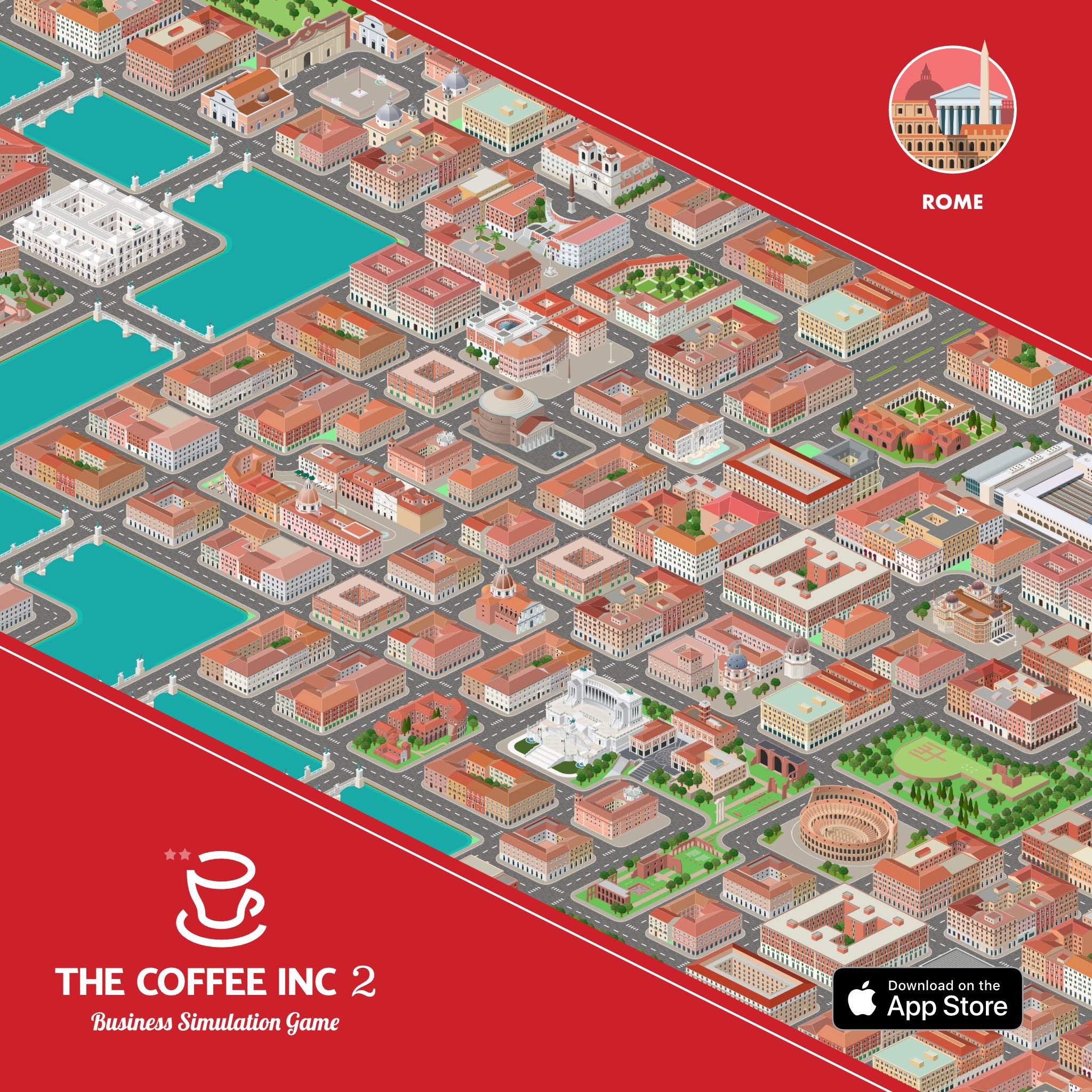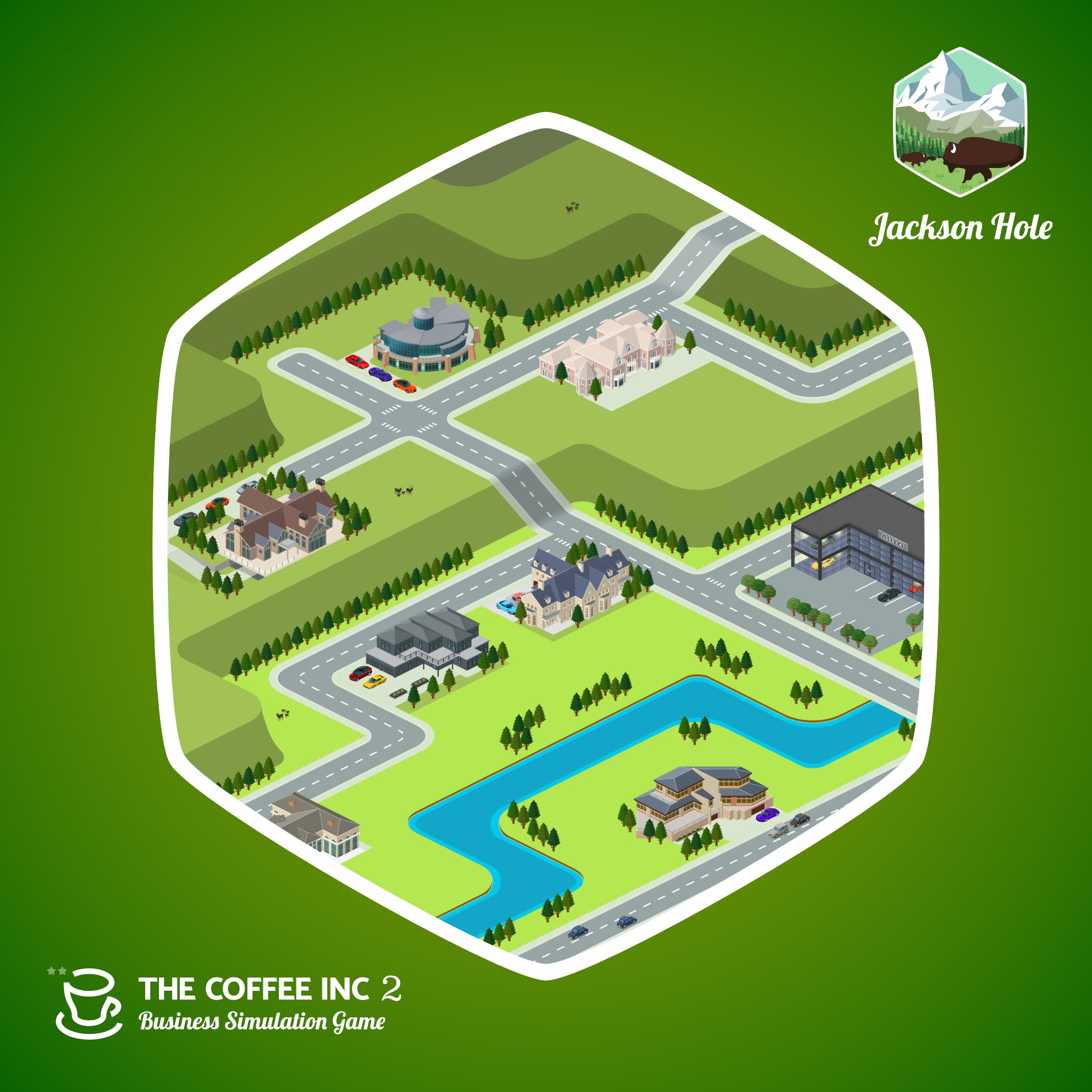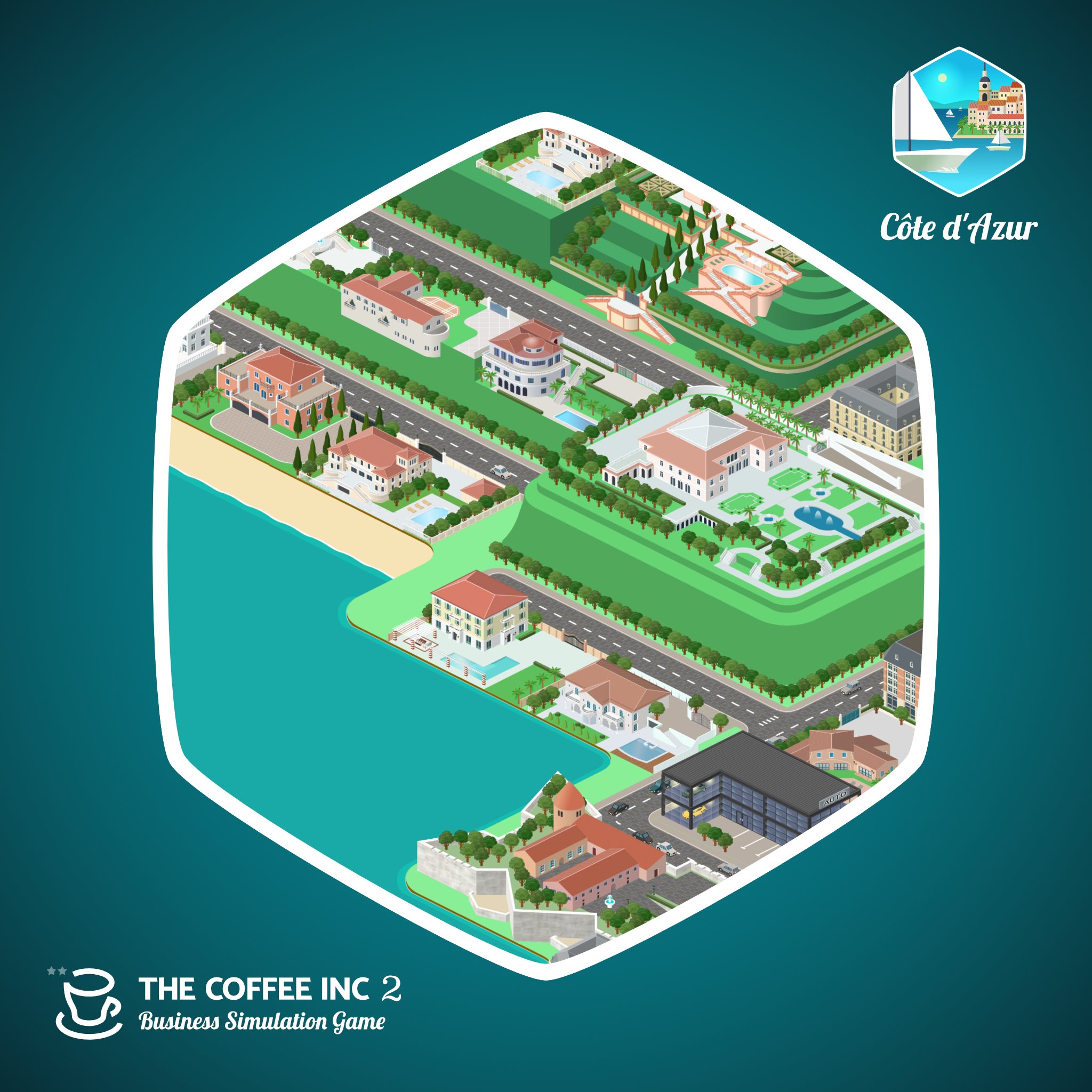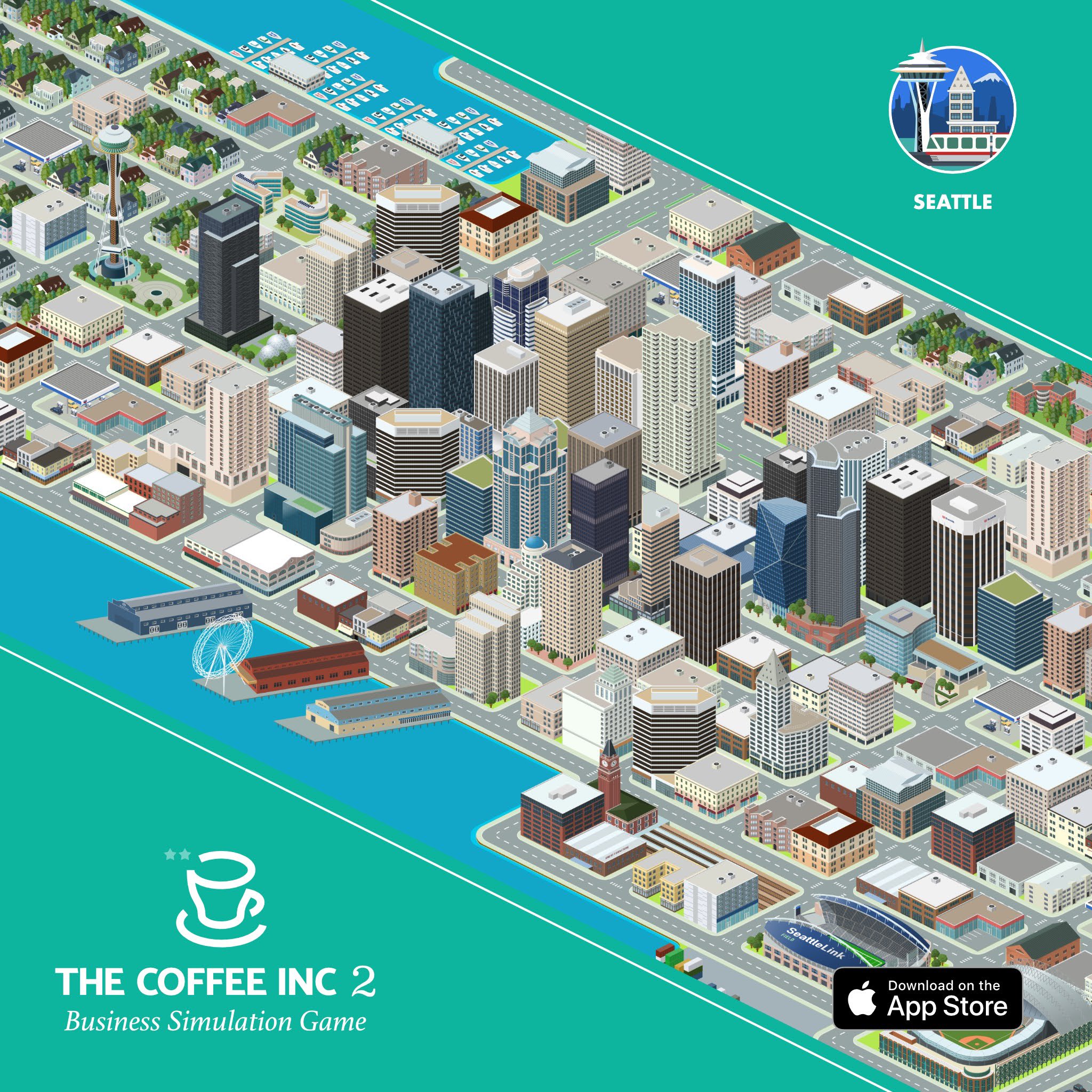Coffee is one of the most widely consumed beverages in the world. With its popularity and cultural significance, it’s no surprise that a business simulator game like Coffee Inc. 2 was created to let players run their own coffee shop empire.
In Coffee Inc. 2, you start with limited funds and work to build your fledgling coffee business into a thriving franchise. The game mechanics revolve around choosing store locations strategically, hiring and managing staff, purchasing equipment, establishing supply chains, marketing your brand, and competing against rival companies.
This comprehensive guide will provide new players with tips, strategies, and analysis for every aspect of the game. We’ll cover the basics of getting started, expanding your operations, optimizing finances, responding to internal and external events, and ultimately achieving total market domination. Read on to learn the ins and outs of building a booming coffee empire in Coffee Inc. 2!
Table of Contents
Starting Your Business
When beginning a new game in Coffee Inc. 2, you’ll first customize your company by choosing a name, logo, brand colors, and other aesthetic details. While personal preference plays a role here, we recommend avoiding gray as your brand color. Since most in-game city maps use gray/neutral tones, your stores can easily blend into the background environment, making them harder to spot. Bold, contrasting colors work best.
Next, you’ll decide key settings like game difficulty, number of competitors, currency type, and critically—your starting capital. While you can choose any amount, we suggest $800,000 to start. This provides enough breathing room to get established without making the early game overly easy. $200,000 is doable but will be more challenging.
With your company formed, it’s time to set up your very first store. Choosing the right location is crucial, as it will impact customer traffic flow, rent/deposit costs, proximity to rivals, and more. When scanning the city map, prioritize lots with 10,000+ weekly foot traffic, as this represents natural demand. Aim for weekly rent under $2,000 if possible, based on your starting funds. Avoid placing your shop too close to competitors, as you want to monopolize the area at first.
Once secured, focus on buying top-notch equipment like a Masotti/La Marazzo espresso machine, Yoneo/Tena coffee brewer, and Varomix blender. Quality equipment ensures tasty drinks and efficient operations. Hire a manager with decent 2-star skills for under $70,000 salary, and have them handle all store responsibilities.
With your first location established, it’s time to start expanding while managing finances wisely.
Optimizing Finances
In the early game stages, income will be low as you rely solely on your starting capital. Careful financial decisions are critical to staying solvent and fuelling growth. Here are tips for optimizing spending during your coffee empire’s fledgling days:
– Minimize costs for store exteriors and interiors. Stick to the cheapest pre-designed options until funds allow for customization.
– Invest in the best equipment your budget allows, even if it’s a stretch. Quality brewing gear translates directly into better drinks, higher reputation, and more customers.
– Buy specialty coffee beans from local roasters instead of using default blends. Unique flavors attract curious customers.
– Hire competent managers for under $70,000 salary. Their expertise saves you time and reduces workload significantly.
– Hold off on buying fancy offices or hiring marketing agencies too soon. Focus spending on your core store operations first.
– Avoid risky stock market investments in the early game. Your limited funds have better uses with more predictable returns.
– Only purchase gameplay expansions once you’ve mastered the base game. The Custom Interiors DLC can be useful though.
– Consider bank loans to quickly gain capital injections, but watch interest rates closely.
– File an IPO to sell company shares once eligible. This raises funds but you’ll lose ownership percentage.
Some other ways to bootstrap your coffers in the lean early days:
– Take advantage of weekly special customer promotions for bonus income.
– Maintain positive net profit each quarter to establish consistent growth trend.
– Research cheaper supply vendors as you expand into more cities.
– Only hire additional staff as needed to keep payroll costs down.
– Use staff break rooms and bonuses to improve productivity and retention.
With smart money management, your small startup can fund its expansion into an empire, one fiscal quarter at a time.
Expanding Your Stores
Starting with your founding location, you’ll want to steadily expand your presence across the city map. Look for areas with strong foot traffic and fair rent when choosing additional sites. Varied pricing tiers cater to different crowds. Maintain some distance between stores to avoid sales cannibalization.
Evaluate entering new cities once you’ve saturated your originating location. Transferring experienced managers helps launch new branches faster. Tailor menus and branding to regional tastes. Build around hubs like city centers, malls, office parks, etc.
When scouting potential spots, consult the game’s data overlays showing traffic flow, demographics, rent costs, and more. Take notes on promising areas you may want to revisit later. Watch for competitors encroaching on your turf as well.
As your operations grow, an office becomes necessary to unlock more advanced options. Start small with a single floor location to minimize overhead. The HR department lets you remotely manage all stores. The R&D department can develop new products and technology. The marketing department handles promotions across regions. And the executive floor houses your C-suite leadership team.
With successors in place, you can step back from day-to-day store oversight to focus on higher level strategy. But keep an eye out for critical store events that may still require your personal attention from time to time.
Advanced Money-Making Tactics
Once your coffee empire has gained momentum, you’ll have excess capital to invest in premium money-making ventures:
– Splurge on lavish over-the-top store designs to attract wealthy clientele.luxury store
– Acquire competitors to absorb their market share.
– Diversify into new business areas like entertainment, hospitality, tourism, etc.
– Establish your own coffee plantations and roasting facilities to control supply costs.
– Create unique brand merchandise that customers will proudly display.
– Develop novel proprietary coffee brewing technology.
– Research innovative new beverages like nitrogen-infused cold brew.
– Open international locations to tap new demographics.
– Launch premium subscription services for loyal brand devotees.
– Take your company public via a major IPO for a huge liquidity influx.
– Establish your brand as a status symbol through elite marketing.
– Purchase outlandish trophies like sports teams, landmarks, and islands.
– Influence politics to shape a business climate that benefits you.
The sky’s the limit once you reach multi-millionaire status! But a well-run coffee empire will generate major profits even without such extravagances.
Hiring and Managing Staff
A good workforce is the backbone of any successful service business. In Coffee Inc. 2, you’ll need to hire and oversee qualified employees in key roles:
Baristas – Your front line staff preparing and serving drinks. Opt for Sociable and Quality-Focused traits.
Managers – Oversee day-to-day store operations. Ambitious and Leadership skills.
Cashiers – Handle transactions and upselling. Friendly and Salesmanship.
Marketers – Plan promotional campaigns. Creative and Analytical traits.
Supply Manager – Source ingredients and handle logistics. Organized and Analytical.
Accountant – Track finances across the company. Meticulous and Analytical.
COO – Runs company operations so you can focus on high-level strategy.
Beyond inherent traits, invest in further developing your team via training courses and seminars. This boosts skills and unlocks new capabilities over time. Make sure to review performance metrics regularly and address any shortcomings.
Provide attractive wage rates and workplace perks like breakrooms, bonuses, and healthcare to improve retention. But don’t hesitate to fire underperforming staff dragging things down.
With a first-class team in place, your stores will run like clockwork, delight customers, and rake in profits.
Mastering In-Game Systems
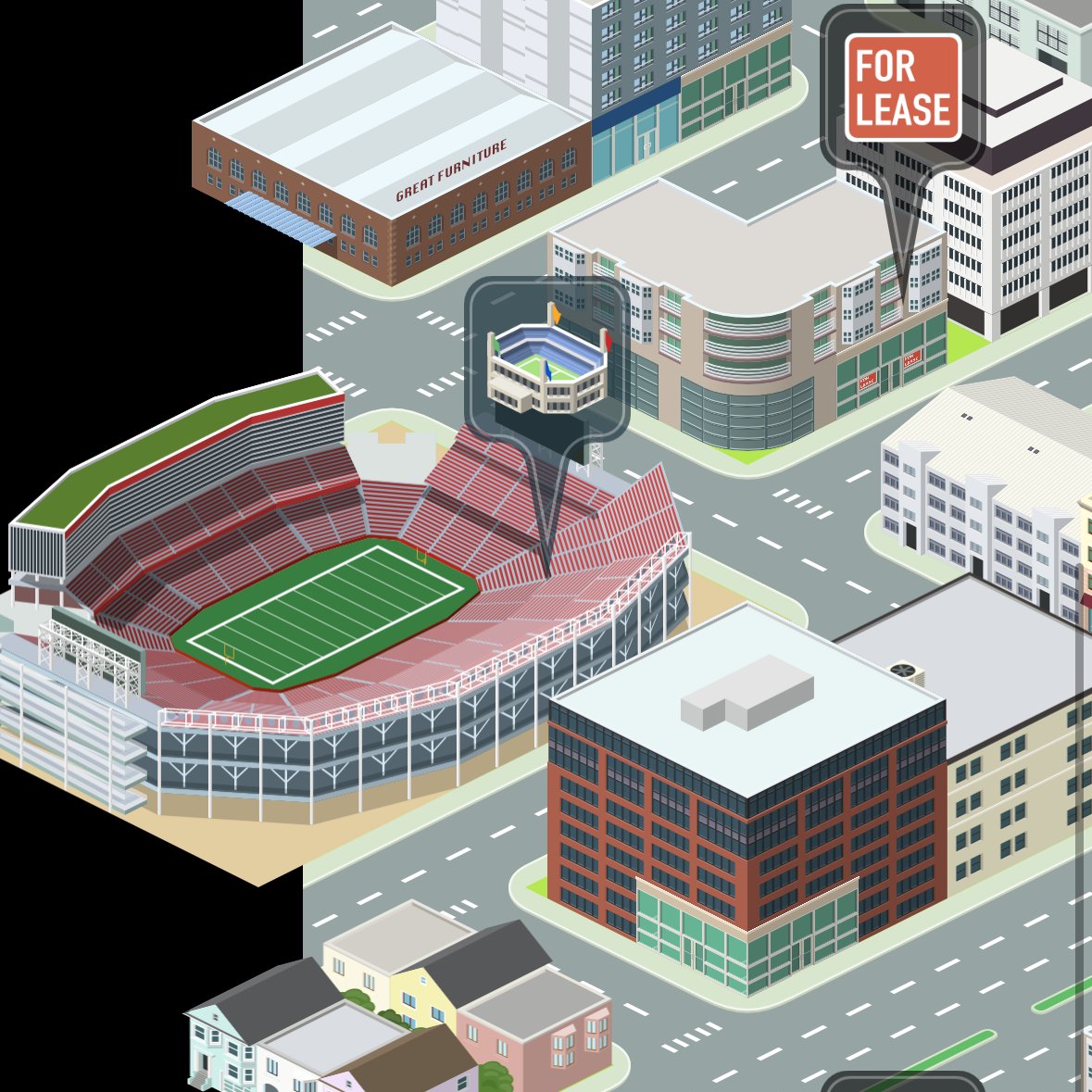
To excel at Coffee Inc. 2, you’ll need to understand its various in-depth mechanics:
Store Setup – Optimizing layout, décor, music, scents, etc. for ambiance and efficiencies.
Supply Chains – Establishing relationships with vendors of equipment, ingredients, and materials.
Customer Preferences – Researching and anticipating regional tastes and trends.
Menu Development – Formulating beverages and edibles catering to your audience.
Quality Control – Ensuring consistency across store locations.
Employee Management – Hiring, training, monitoring, and retaining staff.
Inventory Management – Tracking supply stocks and forecasting demand.
Facility Management – Overseeing maintenance, cleanliness, repairs, etc.
Accounting & Finances – Managing cash flow, income statements, taxes, etc.
Technology Implementation – Leveraging hardware and software to enhance operations.
Logistics Management – Coordinating distribution and shipments between locations.
Marketing & Branding – Building awareness and loyalty through advertising and experiences.
Public Relations – Cultivating positive public and media perceptions.
Competitive Analysis – Researching other brands’ offerings and tactics.
Legal Compliance – Adhering to relevant regulations and requirements.
These areas combine to determine the success or failure of your enterprise. Master them, and market dominance awaits.
Competing Against Rivals
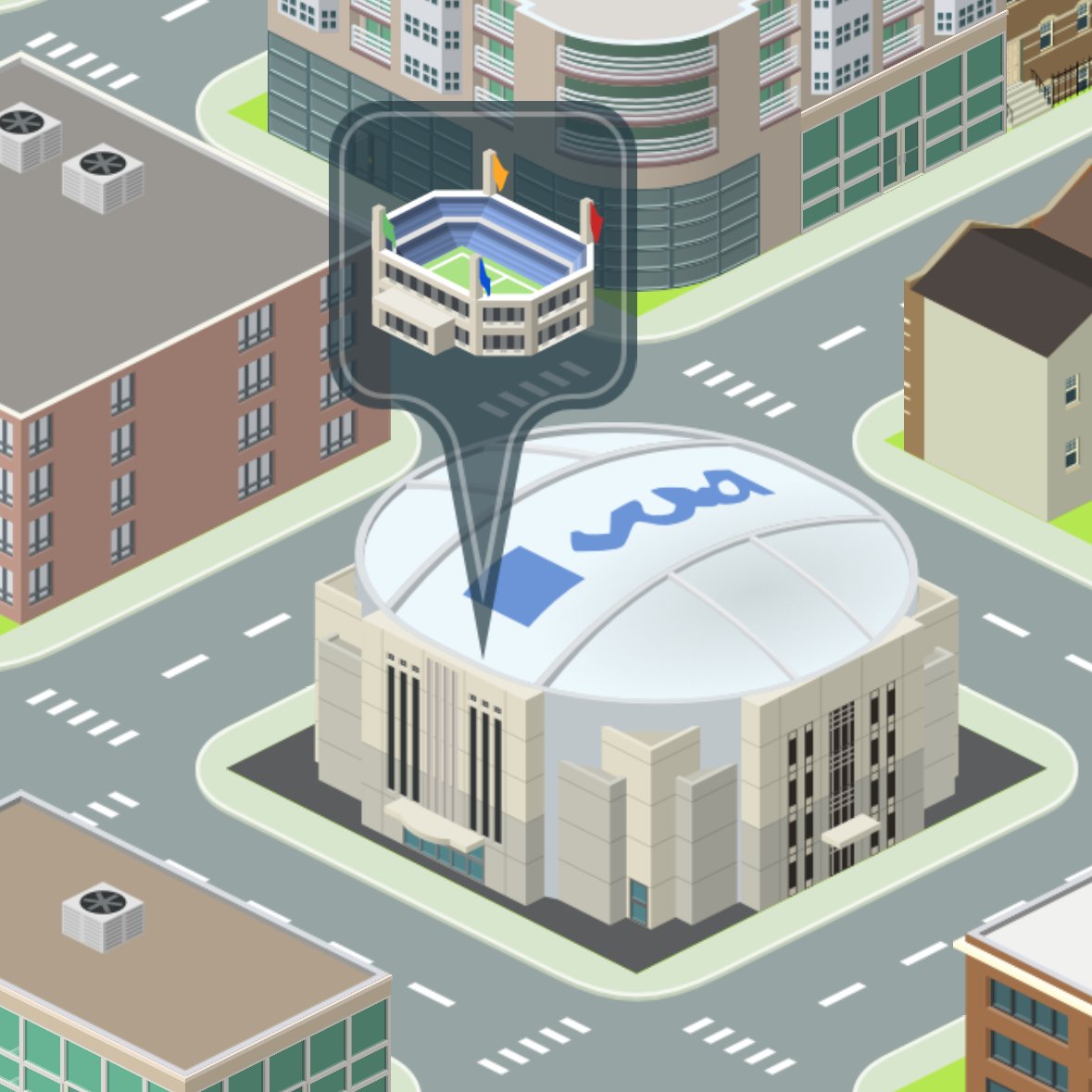
– Maintain quality standards as competition heats up to retain customers. Don’t sacrifice quality to cut costs.
– Study competitors’ tactics and seek to improve upon their approach. Adapt any good ideas into your own operations.
– Leverage multi-store scale and established brand recognition against smaller newcomers.
– Focus on differentiating your brand through premium ingredients, specialty drinks, top-notch service, intelligent store locations, and consistent execution. These build loyalty.
– Monitor competitors’ activities via town newspapers. Quickly counter major encroachments on your territory.
– Acquire struggling rivals before they can improve or be bought out by others.
– If needed, undercut competitors’ pricing temporarily in a specific area to suffocate their location, but avoid starting city-wide price wars.
– Lobby local officials for regulations like zoning restrictions that inconveniently impede competitors.
– Launch localized marketing blitzes against competing stores to sway customers. Poach employees to obtain intel.
– Study sales patterns to avoid directly mirroring outlets in close proximity to rivals.
– Bake loss-leading locations into expansion plans to box out competitors from certain areas.
– Strike exclusive deals with key real estate holders and suppliers to restrict competitors’ options.
– Cultivate community goodwill to insulate your brand against aggressive competitors.
With clever maneuvering, you can stay 10 steps ahead of would-be rivals. But avoid risky over-expansion and over-committing resources in the process.
Optimizing Shop Operations

Your stores themselves are the heart of the enterprise. Mastering retail-level execution is critical:
Location – Foot traffic, demographics, parking, public transit, area reputation and safety. Have appealing exterior storefront and signage.
Layout – Well-organized floorplan with clear queues. Tables situated for convenient access, conversations, and ambient monitoring.
Atmosphere – Soothing music, pleasant natural aromas, warm lighting, artisanal decorations, and relaxing tones make customers linger.
Equipment – Quality high-capacity espresso machines, coffee brewers, blenders, etc. facilitate making many quick and consistent drinks.
Hygiene – Spotless environment and sanitary drinkware. Constant cleaning procedures. Proper trash disposal and pest control.
Inventory – Fully and consistently stocked ingredients, cups, napkins, and key supplies to avoid shortages. Monitor freshness.
Staffing – Friendly competent baristas provide speedy and attentive service with a smile. Manager oversees with quality focus.
Menu – Offering a wide variety of popular regular drinks, premium beverages, fresh pastries and snacks, merch, and regular specials and seasonal options.
Service – Fast order taking and fulfillment. Flexible customizations and modifications. Handcrafted quality focus.
Payment – Accept all major payment types with integrated point-of-sale system. Upsell individuals and corporate accounts.
Get these store-level details right, and your locations will run like well-oiled machines, delight customers, build loyalty, and maximize sales.
Analyzing Performance Metrics
Key performance indicators quantify the health of your enterprise. Track these closely:
– Sales Revenue – Total monies generated from all transactions
– Profit Margin – Portion of sales revenue retained after expenses
– Market Share – Portion of overall market captured by your brand
– Customer Wait Times – How long queues take during rushes
– Customer Reviews – Sentiment and satisfaction ratings
– Customer Loyalty – Repeat business and engagement metrics
– Brand Awareness – How recognized your brand is by general populace
– Store Cleanliness – Internal and external maintenance standards
– Equipment Uptime – Percentage of time machinery is operational
– Inventory Waste – Lost ingredients due to spoilage and expiration
– Employee Retention – Turnover rate for staff
– Employee Productivity – Sales and service metrics per worker
– Training Hours – Time invested in educating personnel
– Management Performance – Success meeting targets and metrics
Regularly compile and analyze these KPIs across all locations to catch any developing issues early. Address weaknesses before they become major problems. And continue optimization efforts in well-performing areas.
Adapting to a Changing Market

As your company grows, you must continually adapt to evolving conditions:
Industry Trends – Keep pace with or drive innovations in equipment, ingredients, preparation techniques, branding, customer experiences, etc.
Demographic Shifts – Cater offerings, atmospheres, and marketing to changing population tastes and lifestyles.
Real Estate Shifts – Adjust locations and redevelop stores to follow evolving neighborhoods. Watch commercial rents.
Economic Cycles – Counter recessions with budget-friendly offerings. Capitalize on booms with premium experiences.
Seasonal Changes – Roll out holiday drinks menus and interior decorations. Staff-up for sales surges.
Competitor Moves – Rapidly respond to rivals’ new store openings, product launches, mergers, marketing campaigns, etc.
Regulatory Changes – Track local laws and respond to higher wages, recycling rules, zoning policies, sugar taxes, etc.
Public Perception Shifts – Address PR issues and refreshing stale brands early.
Technology Disruption – Embrace innovations like mobile apps and payment services.
Supply Chain Disruptions – Have contingency plans and alternate vendors if needed.
Health Trends – Offer lower calorie, lower sugar, high protein, etc. options.
To sustain growth long-term, your brand must evolve along with consumer tastes and market forces. But don’t lose sight of your core competitive advantages.
Leveraging Marketing, Advertising & PR
Promoting and managing public perceptions of your company is critical. Effective techniques include:
– Logo – Have a memorable and meaningful brand logo instilling quality associations.
– Brand Messaging – Consistent taglines and themes communicating your values and differentiators.
– Advertising – Well-targeted radio, television, billboard, and online ads building awareness.
– Social Media – Engaging platform presence to connect with customers.
– Influencer Partnerships – Aligning with prominent tastemakers expands reach.
– Storefront Signage – Interior and exterior signs convey brand identity.
– Merchandise – Branded apparel, mugs, bags, etc. provide free advertising from customers.
– Sponsorships – Supporting events and causes earns community goodwill.
– Partnerships – Co-marketing with complementary brands expands awareness.
– SEO – Boosting search engine rankings for relevant keywords.
– Email Marketing – Collecting opt-ins for promotions, newsletter updates, and surveys.
– Referral Programs – Rewarding existing customers for sharing with friends.
– Reviews Management – Thanking positive reviewers and addressing negatives constructively.
– PR Outreach – Cultivating media coverage and profiles.
– Influencing Media Narratives – Mitigating bad press and controversies.
– Industry Awards – Leveraging accolades to reinforce quality.
Get your branding right, and your stores will be packed with devotees raving about your company.
Navigating Business Regulations
As your enterprise grows, you’ll have to contend with an expanding world of legal and regulatory frameworks:
– Business Licensing – Registering properly in all jurisdictions you operate.
– Food Safety – Adhering to preparation, handling, and storage regulations.
– Labor Laws – Abiding by wage, breaks, benefits, anti-discrimination, safety requirements, etc.
– Health Codes – Maintaining proper facilities cleanliness, food temperatures, employee hygiene, etc.
– Taxes – Properly tracking, submitting, and paying all required corporate, sales, payroll, and other taxes.
– Zoning Laws – Ensuring store locations and facilities meet area requirements.
– Environmental Regulations – Following rules around energy use, waste disposal, emissions, etc.
– Accessibility – Accommodating those with disabilities.
– Data Privacy – Securely handling customer information.
– Food Labeling & Nutrition – Meeting disclosure and claim requirements.
– Weights & Measures – Using calibrated and inspected equipment.
– Insurance Coverage – Maintaining proper policies and following requirements to prevent liabilities.
While dry, legal diligence minimizes major disruptions and penalties over time as scrutiny rises. Consult lawyers and accountants to ensure full compliance.
Using Technology to Your Advantage
Innovative technology can give your brand a competitive advantage:
– Point-of-Sale Systems – Modern registers enable seamless ordering, transactions, metrics, and inventory management.
– Mobile Apps – Allow online orders, payments, promotions, and customer accounts.
– Kiosks – Self-service machines provide another ordering avenue and reduce labor costs.
– Delivery Services – Enable serving customers outside
Responding to In-Game Events
As your coffee business grows in Coffee Inc. 2, you’ll encounter major in-game events that require your attention and decision-making:
Store Opening Events – Ribbon cuttings, grand opening sales, and VIP soft openings generate buzz for new locations.
Supplier Negotiations – Leverage growing order volumes to press for better pricing and terms from vendors.
Equipment Breakdowns – Rapidly resolve mechanical issues to limit sales disruptions during outages.
Employee Misconduct – Don’t tolerate problematic behavior that impacts operations.
Employee Training Requests – Approve seminars and courses to build critical skills.
Employee Quits – Counter resignation notices by meeting or beating salary offers to retain key staff.
Rival Expansions – React quickly to competitors moving into your territories.
Customer Incidents – Address complaints, injuries, disturbances, etc. promptly and appropriately.
Food Safety Violations – Resolve health inspector issues completely and immediately.
Lawsuits & Legal Issues – Consult lawyers to protect company interests.
Loan Requests – Weigh financing carefully to fuel growth vs. risking overleverage.
Local Elections – Support officials with favorable pro-business policies.
Policy Proposals – Lobby against unfavorable laws and regulations impacting operations.
PR Nightmares – Manage blowback from scandals or controversies through transparency and action.
Economic Downturns – Adjust budgets and inventory orders conservatively in recessions.
Natural Disasters – Follow emergency response plans to protect assets and people.
Viral Trends – Capitalize on buzzworthy moments with relevant limited-time offerings.
Shipping Delays – Ration inventory and source backup suppliers if supply chains falter.
Watch the headlines for unfolding developments, and be ready to make bold decisions when faced with uncertainty. But gather enough information to make informed moves.
Foreign Expansion Considerations
Once you’ve conquered the domestic market, expanding globally opens new frontiers:
– Research target countries’ coffee preferences to tailor drink menus and food offerings. Adjust ingredients and preparation styles accordingly.
– Study foreign real estate dynamics and optimal store locations. Street-level visibility and ease of access remain important.
– Prepare for higher inventory costs when importing specialized machinery and exotic coffee beans. Secure favorable international vendor terms in advance.
– Learn regional HR practices regarding wages, benefits, time-off, and labor regulations.
– Invest in local language and cultural training for expatriate managers overseeing new territories. Hire local talent when possible.
– Adapt branding and marketing content for translation and resonance in different cultures.
– Consult tax professionals to navigate complex international regulations and requirements around royalties, VAT, corporate tax rates, etc.
– Monitor global economic and political developments that may impact foreign operations. Be cautious expanding into unstable regions.
– Expect privatized and inefficient infrastructure in some nations, requiring workarounds.
Going global brings major new opportunities but also operational complexities. Proceed carefully with extensive upfront research and planning.
Avoiding Critical Mistakes

While running your coffee empire, steer clear of these catastrophic blunders:
– Expanding too fast without adequate capital, inventory, or staff.
– Degrading product quality and service in pursuit of profitability. This destroys brand reputation.
– Ignoring changing consumer preferences and demographics.
– Failure to understand and comply with legal and regulatory requirements.
– Not responding quickly enough to new competitive threats.
– Paying insufficient attention to vendor selection resulting in supply issues.
– Failure to monitor inventory levels and product freshness.
– Preventable food safety incidents that risk customer health.
– Poor location selections based on faulty or limited analysis.
– Excessive short-term cost cutting that causes long-term value destruction.
– Loss of focus on core coffee offerings while diversifying into unfamiliar areas.
– Lack of proper financial planning and controls.
– Failure to develop managerial successors before scaling back your role.
– Declining PR and reputation mismanagement.
– Technology and innovation missteps like betting on the wrong systems.
– Inadequate marketing investment allowing competitors to overtake mindshare.
While mistakes are inevitable, acknowledge and rectify them before they spiral out of control. Stay vigilant.
Choosing Your Starting City

When beginning a new game of Coffee Inc. 2, your very first decision is which starting city to launch your business in. This initial location will serve as your flagship, so choose wisely based on the specific pros and cons of each option:
San Francisco
Pros:
– Generally low rents for storefronts
– Recognized cultural reputation that attracts tourists
Cons:
– Low overall foot traffic compared to other cities
– High local competition that may attempt to undermine your first location
Recommendation: Avoid as starting city unless you get very lucky with an ideal rental deal. Low traffic will slow initial growth.
Chicago
Pros:
– Balanced mix of low and high rent locations
– Some areas have very strong foot traffic
Cons:
– Highly competitive market with aggressive rivals
Recommendation: Viable starting city with high upside but requires winning some bidding wars for prime spots.
Seattle
Pros:
– Relatively fair rents and decent foot traffic
Cons:
– Lacks superb bargain locations to jumpstart growth
Recommendation: One of the safer starting cities but offers less long-term upside than others. Consider if you want a mellow beginning.
New York City
Pros:
– Major global brand destination
Cons:
– A hyper-competitive market with exorbitant rents across the board
Recommendation: Avoid for new players. The excessive rents will crush you before you get off the ground unless you luck out.
London
Pros:
– Numerous cheap locations available
– International brand destination
Cons:
– High foot traffic locations still expensive
– Many low traffic slots
Recommendation: The abundance of discount real estate makes London an ideal initial launch point for bootstrapping players.
Paris
Pros:
– Balances affordable and premium spots
– World fame draws tourists
Cons:
– High competition for the best areas
Recommendation: A very solid starting city like Chicago but with more bargain options. Recommended startup locale.
Berlin
Pros:
– Very affordable real estate options abound
Cons:
– High foot traffic slots are still limited
Recommendation: Another great option for initial launch location if you can nab one of the good value, high traffic storefronts early.
Tokyo
Pros:
– Lots of discounted rental options
– Exciting global destination market
Cons:
– High traffic locations get pricey
Recommendation: The abundance of cheap starting spots combined with the city’s famous profile make Tokyo a prime candidate for new players.
Osaka
Pros:
– Very inexpensive real estate
Cons:
– High traffic locations still limited
Recommendation: If you can win one of the few prime spots, Osaka is a top cheap startup city. Otherwise options are very limited long-term.
Amsterdam
Pros:
– Cheap rent across the board
Cons:
– Almost no high foot traffic locations to leverage
– Hyper-competitive coffee market
Recommendation: Difficult starting environment overall. Low upside. Avoid unless on an extreme budget.
Based on this analysis, we recommend new players launch in either London, Paris, Berlin, Tokyo, or Osaka to maximize affordable options while benefiting from internationally renowned locales. Pick the culture that most appeals to you. Avoid NYC at all costs when starting out.
Optimal Starting Funds
In Coffee Inc. 2, you choose how much starting capital to launch your empire with. More funds offer more flexibility, but also make the game easier. Here is an analysis of varying starting budgets:
$200,000 Budget
Pros:
– Provides an extreme challenge requiring flawless execution
– Forces you to learn financial optimization quickly
– Unlocks maximum reward for skillful bootsrapping tactics
Cons:
– Leaves almost no room for early mistakes or recoveries
– Severely limits initial real estate options
– Can result in unwinnable disadvantage against aggressive competitors
$400,000 Budget
Pros:
– Still provides robust challenge and need for strategic financing
– Lets you purchase better initial equipment and staff sooner
Cons:
– Still very tight budget cap with need for excellent money management
– Top location may remain beyond reach at launch
$600,000 Budget
Pros:
– Comfortable cushion for absorbing minor early setbacks
– Opens path to prime locations if willing to spend a large portion upfront
– Enables hiring expert manager sooner to bootstrap growth
Cons:
– Substantially easier opening phase compared to lower budgets
– Still cannot afford many luxury expansions right away
$800,000 Budget
Pros:
– Allows securing a top-tier location in most cities
– Peace of mind to recover from unexpected early hurdles
– Opens most vendor and staffing options
Cons:
– Certainly an easier opening challenge than lower budgets
– Excess funds may enable sloppy financial management initially
$1,000,000+ Budgets
Pros:
– Trivializes nearly all basic economic challenges in the game
– Allows lavish spending on premium locations, equipment, etc.
– Enables maximum flexibility in response to competition
Cons:
– Provides very little financial challenge or incentive to optimize costs
– Growth becomes more about speed than strategic financing
– Hard to lose, reducing sense of reward
Based on the above, we recommend either $600,000 or $800,000 starting capital for most players to provide adequate challenge and flexibility. Players craving intensity can drop down to $400,000 or $200,000. Those seeking relaxation may enjoy $1 million+.
Maximizing Customer Accessibility
As you expand, try to ensure a store location is within quick reach of every neighborhood, so you don’t lose sales simply due to convenience factors:
– Analyze population density patterns around commercial centers. Identify underserved residential districts.
– Watch for competitors encircling your locations and reducing your accessibility. Fill in any gaps they create.
– Realize coverage zones based on typical walking time radiuses. Seek 5-10 minute proximity for urban stores, 10-15 minutes in less dense suburbs.
– Account for public transit hubs and major traffic thoroughfares in your analysis. Sites directly on transit lines or busy intersections often perform best.
– Provide parking access wherever feasible, even if paid, as many customers will opt to drive. Just ensure ample nearby street parking or dedicated lots.
– Locate shops on both sides of natural separations like rivers or highways obstructing passage. Don’t make unwarranted detours necessary.
Getting these convenience factors right ensures you capture all available demand in each region. Missed sales due to accessibility issues are pure profit leakage.
Leveraging Store Clusters
Another advanced expansion tactic is saturating regions with store clusters:
– Open 3-5 locations within a several block radius to dominate the local market through sheer proximity.
– Ideal for heavy commercial centers, office parks, etc. where foot traffic is highly concentrated.
– Allows efficiently fulfilling demand surges in busy zones when stores can support each other.
– Creates a localized brand halo showcasing your dominance and familiarity to attract new customers.
– Discourages competitors from directly encroaching on your turf since you can retaliate locally.
Just beware oversaturation that results in same-brand locations cannibalizing each others’ sales. Careful market research and site selection avoids this.
Adapting to Regional Tastes
Customize your menu, ingredients, preparation styles, and decor to local tastes:
– Observe recipes and ingredients that are popular in each city. Talk to managers.
– Adjust coffee bean sourcing and roasting styles to cater to regional palates.
– Target local customer demographics with food and merchandise options.
– Tweak store designs to match local aesthetic sensibilities and expectations.
– Run test stores when entering new cities to gauge preferences before wide rollout.
– Promote locally inspired signature drinks and custom creations.
– Time limited promotions and seasonal menus around local events and holidays.
– Advertise in native languages with locally resonating messaging.
– Partner with regional businesses, personalities, and causes.
Adapting to each market grows customer loyalty and satisfaction while building goodwill. Don’t take a one-size-fits-all approach.
Optimizing Store Atmospherics

Store ambiance greatly impacts customer experiences. Perfect these elements:
– Lighting – Bright enough for comfort yet muted for relaxation. Layer fixtures and bulbs for warmth. Use natural light where possible.
– Aromas – Coffee obviously, but balance with subtle pleasant fruity and sweet scents. Keep air fresh without overwhelming.
– Sounds – Upbeat yet unintrusive music complementing the vibe. Minimize noisy machinery.
– Colors – Earthy tones like rich browns, reds, greens. Avoid cold hues like grays and blues. Use colors to designate areas.
– Textures – Natural wood surfaces and fixtures. Brick or textured walls. Avoid sterile plastics. Use decorative etchings and patterns.
– Temperatures – On the warmer side but not hot. Provide gas patio heaters for outdoor seating.
– Art – Tasteful paintings and photography featuring coffee themes and regional scenes. Showcase local artists.
– Furnishings – Comfortable padded chairs conducive to conversation. Sofas for lounging. Charging outlets.
– Flow – Intuitive layout with clear paths. Feature menu for easy ordering. Define waiting areas.
Get these elements right, and customers will happily soak in the atmosphere – and purchase more items.
Leveraging the Mobile Workforce
Attract increasing ranks of mobile workers by catering to their unique needs:
– Provide ample, easily accessible power outlets throughout stores.
– Offer spacious working tables and comfortable lounge seating suitable for working.
– Set up free customer wifi with fast, reliable bandwidth and internet speeds.
– Allow internet calls, but gently remind those getting too loud.
– Install sound-dampening room dividers and materials to reduce noise.
– Offer corporate accounts for mobile work teams for volume discounts.
– Extend late night hours to serve after-office-hours work sessions.
– Partner with coworking spaces on promotions and corporate memberships.
– Host events like “Coffee and Code” aimed at programmers and creatives.
By becoming known as a remote work hub, you’ll win consistent business even during slow hours.
Optimizing Menu Offerings
Your menu selection can make or break your locations. Ensure your offerings hit the following marks:
– Feature core espresso drinks like lattes, cappuccinos, americanos, etc prepared properly using quality beans.
– Offer plenty of milk options – whole, 2%, skim, soy, almond, oat.
– Include brewed drip coffee options in light, medium and dark roasts. Have decaf.
– Provide alternative brew methods like pour over, cold brew, french press for variety.
– List specialty flavored drinks for broad appeal – mochas, vanilla lattes, caramel macchiatos, etc.
– Offer seasonal/limited drinks around holidays, weather, and cultural events.
– Provide a selection of fresh bakery items like muffins, scones, croissants to complement drinks.
– Offer grab-and-go sandwiches, protein packs, parfaits for heartier appetites.
– Accommodate common restrictions like gluten-free, dairy-free, low-calorie.
– Sell branded merchandise – mugs, shirts, hats, bags, tumblers.
– Post easy-to-read illustrated menus with descriptions and images of each item.
– Feature regular weekly/monthly specials and discounts to drive repeat visits.
Give customers plenty of reasons to visit anytime with broadly appealing variety.
Advanced Tactics for Market Domination
When you’ve grown into a coffee empire, consider bold power plays:
Acquire Competitors
Buying out rival chains bolsters market share and eliminates a threat in one move. Look for struggling competitors or smaller chains to subsume more easily.
Launch Spin-off Brands
Satisfy new demographics by launching differentiated sub-brands – premium reserve line, budget value brand, tea-focused shops, etc.
Develop Proprietary Technology
Invest in R&D for innovative brewing techniques and equipment to gain advantage. Patent inventions so imitators pay you royalties.
Integrate Vertically
Control costs and quality by acquiring your own coffee plantations, roasting plants and distribution channels.
Diversify Offerings
Leverage coffeehouse store footprint for new concept additions like juices, ice cream, beer & wine, food, etc.
Influence Politics
Lobby officials with “campaign contributions” to sway policies in your economic favor.
Take Your Company Global
Expand worldwide to tap new demand and gain prestige.
Go All-In on Customer Service
Make world class service a brand hallmark, empowering staff to delight.
Disrupt Your Own Business
Introduce new formats staying ahead of shifting consumer expectations – mobile coffee trucks,
The sky’s the limit once your empire achieves market dominance!
Staffing & Employees – Additional Tips
Key Traits to Seek Out When Hiring:

Baristas:
– Passionate about coffee
– Hospitality mindset
– Advise on options without overwhelming
– Work quickly without sacrificing quality
– Friendly and upbeat
Managers:
– Leadership skills
– Business savvy
– Hospitality experience
– Work ethic
– Analytical
Marketers:
– Creative
– Data-driven
– Technologically adept
– Understand target demos
– Experienced with advertising channels
Accountants:
– Highly organized
– Detail-oriented
– Analytical
– Proficient with accounting software
– Methodical
Supply Chain:
– Logistics experience
– Negotiation skills
– Data analysis abilities
– Vendor relationship skills
Food Prep:
– Culinary training
– Cleanliness habits
– Attention to health codes
– Ability to follow recipes
– Efficiency
Developing Talent From Within

Promoting from within retains knowledge and boosts loyalty. Tactics include:
– Documenting employee skills, aspirations, and development areas to guide advancement.
– Providing training programs, tuition assistance, and learning stipends.
– Job shadowing, mentoring, and stretch assignments to gain new experience.
– Internships to evaluate and develop promising junior talent.
– Clear criteria for promotion eligibility and timeframes.
– Manager-in-training programs to ready leaders.
– Ensuring qualified internal applicants get priority interview access and consideration.
Take a personal interest in mentoring standouts. This builds a strong leadership bench ready as you expand.
Onboarding Best Practices
A thorough onboarding process sets new hires up for success:
– Introduce company history and culture. Share founder vision stories highlighting values.
– Tour office spaces and shops to welcome them into physical spaces.
– Set clear expectations and responsibilities in writing.
– Explain performance metrics and how they are measured.
– Review policies, procedures, tools, and resources they will use daily.
– Introduce to peers and key cross-functional partners.
– Provide welcome package with company swag.
– Assign a peer buddy to help navigate unwritten norms and culture.
– Schedule 30/60/90 day check-ins to provide feedback.
– Collect continuous feedback on their onboarding experience to improve.
First impressions matter! Make new hires excited for their future contributions.
Offboarding Best Practices
How employees are treated on departure profoundly impacts your employer brand. To avoid negativity and lawsuits:
– Provide generous severance, extended healthcare, career counseling, references, etc.
– Don’t publicly share reasons for termination. Keep discussions discreet.
– Let the employee positively spin circumstances however they want.
– Avoid trying to enforce non-competes and stifle careers.
– Provide glowing recommendations to future employers.
– Allow them to say proper goodbyes to key contacts.
– Schedule exit interviews to understand their reasons for leaving.
– Ask departing managers for documentation to ensure continuity.
– Collect company property through pre-agreed upon channels.
– Invite alumni to social events and check in on their new roles.
Treating all as valued alumni preserves your appeal for future recruits.
Compensation and Benefits Strategies

Getting pay packages right is key for attraction and retention:
– Offer wages above industry averages – Target 10-15% higher base along with bonuses.
– Incentivize personal and store performance with commissions and profit sharing.
– Consider employee ownership plans via stock grants or options.
– Provide benefits like health insurance, life insurance, 401(k), HSA even for part timers.
– Allow trading shifts for schedule flexibility and work-life balance.
– Offer generous vacation time, parental leave, caregiver leave.
– Provide advancement opportunities, professional development stipends, tuition reimbursement.
– Reward loyalty with length of service sabbaticals, increased PTO, etc.
– Offer conveniences like free drinks, snacks, meals, commuter benefits, gym discounts.
– Appreciation bonuses, peer recognition, awards for reaching milestones.
Remember, you get what you pay for. View compensation strategically rather than as pure cost.
Developing Managerial Successors
To sustain growth, continuously develop capable leadership successors at all levels:
– Hire those with clear management potential into individual contributor roles first to evaluate strengths.
– Place high potentials on accelerated promotion paths to build experience quickly.
– Assign mentor relationships with experienced managers for guidance. Enable job shadowing.
– Fund management training programs, seminars, case studies and Harvard Business Review subscriptions.
– Let promising talent run test locations or new initiatives to prove themselves.
– Have managers document institutional knowledge via manuals to transfer wisdom.
– Test leadership skills with roles managing seasonal staff surges.
– Maintain clear succession plans for each top role with both emergency and planned contingencies.
– Drive engagement
Inventory Management Best Practices
Smooth store operations rely on proper inventory management:
– Track item usage rates and seasonal demand shifts to forecast needs.
– Build in supply buffer for unpredictability and delays. Carry more stock of top sellers.
– Take regular inventories and cycle counts to fix discrepancies between recorded and actual.
– Standardize stock levels across stores based on sales volume for consistency.
– Configure automatic reordering triggers to keep core items always available.
– Negotiate contracts with vendors that minimize variability in pricing and availability.
– Leverage volume discounts from vendors without overstocking.
– Always monitor expiration dates and ingredient freshness. First in, first out stock rotation.
– Provide training on proper storage conditions – refrigeration, freezing, dry shelves, etc.
– Control access to stockrooms and ingredient supplies to prevent overuse and theft.
Maintain robust processes and you’ll never face a surprise outage leading to lost sales.
Reducing Customer Wait Times
Excessive waits frustrate customers. Ensure speedy fulfillment with:
– Technology for automated and rapid order taking.
– Menu limitations during rushes to avoid order backups.
– Flexible staffing to add registers and baristas during peak hours.
– Prepared grab and go items for quick hand-off.
– Pre-batched cold brew concentrates and syrups to combine quickly with milk.
– Batch brewing popular roasted options.
– Layout that encourages queue formation and order readiness before pick up.
– Signage that sets expectations about busier wait periods.
– Manager empowered to comp drinks if excessive waits occur due to staffing gaps.
– DoT matrix style boards that show queued orders and expected wait times.
Prompt hand-offs make waits more tolerable while correcting delays preserves loyalty.
Sanitization and Cleanliness Standards
Customers expect pristine conditions. Never cut corners here:
– Schedule daily cleaning tasks – floors, bathrooms, windows, display cases, etc.
– Hourly wiping down of tables, chairs, counters and high touch surfaces like door knobs, sinks, etc.
– Using separate sanitized cloths and spray bottles for front, back and restroom areas. Color code them.
– Individual sanitized wipes for keyboards, tablets, and electronics.
– Proper cleaning equipment like industrial vacuums and sanitizing floor cleaners.
– Weekly exhaustive deep cleaning sessions. Monthly vent and duct cleanings.
– Decluttering unnecessary items that collect dust and dirt. Proper surface material choices.
– Handwashing routines and requirements for staff.
– Regular outside pressure washing and touch ups.
– Immediate response to spills, accidents, and messes.
– Random undercover cleanliness inspections.
sparkling interiors must remain non-negotiable regardless of traffic levels.
Training Programs and Regimens
Continuous training keeps skills current:
– REQUIRE sanitization certifications for everyone before working.
– Schedule routine equipment proficiency refreshers and new feature unveils.
– Send managers to hospitality and service seminars at least quarterly.
– Bring in guest experts for demos – latte artists, sensory analysis, brew methods.
– Document recipes, processes, standards in easily referenced wikis.
– Require new staff to shadow top performers to learn quality shortcuts.
– Set goals for monthly learning hours per employee. Gamify with rewards.
– Host friendly internal competitions around service, quality, etc.
– Run drills for emergency situations – rushes, machine failures, injuries.
– Role play customer scenarios that require de-escalation skills.
– Pay tuition for advanced external certifications and college degrees.
– Test and remediate knowledge gaps with quizzes and refreshers.
Continuous skills development means continuously better customer experiences.
Restaurant style Operations
Borrow practices from restaurants for smoother fulfillment:
– Take written orders at tables to reduce lines. Enter directly into POS.
– Use table tents to notify servers orders are ready for pickup.
– Have bus staff clear and reset tables after patrons leave.
– Employ runners to deliver orders to tables during rushes.
– Use microphones or notification systems tell kitchen staff what was ordered.
– Number orders for easy grouping, sequencing and tracking.
– Schedule in shifts with overlaps for smoother hand-offs.
– Have apprentice understudy roles during peak periods to backfill.
– Batch tasks like brewing coffee, preparing paninis, etc for faster assembly.
– Stock serving supplies at delivery endcaps – lids, sleeves, sugars, milks, etc.
Perfecting the dance between front and back of house cuts delays and steps.
Leveraging Technology for Efficiency
Use tech to enhance store operations:
– Robust point of sale (POS) system to quickly enter orders, process payments, track inventory, compile reports, communicate to back. Integrates with other systems.
– Digital menu boards with dynamic pricing and live updates. Integrate with POS.
– Ordering kiosks for self-service and mobile order pickups.
– Digital signage outside displaying wait times, new products etc.
– Mobile apps for ordering ahead, earning rewards, self checkout.
– Digital kitchen displays and tablets to receive orders from POS.
– Motion sensors to alert when walk-ins are waiting to be seated.
– Wireless handheld POS tablets servers can carry for tableside ordering and payment.
– Reservation systems to space out customers, avoid walkout frustrations.
– Customer pagers that buzz when order is ready at crowded stores.
– Back office analytics on sales patterns, customer metrics, inventory etc.
Tech streamlines operations, unlocks efficiencies, and improves agility.
Facility Maintenance Operations
Proper facilities maintenance prevents disruptions:
– Keep instruction manuals detailing equipment operations and ideal settings. Follow all guidelines.
– Create maintenance checklists for daily, weekly, and monthly preventative upkeep tasks. Don’t skip!
– Use maintenance request ticketing systems. Address issues immediately before small problems balloon.
– Maintain recommended spare parts inventories for critical equipment like espresso machines.
– Keep redundant equipment as failovers when possible – extra POS, backup milk frothers etc.
– Schedule deep cleaning cycles including ceiling, vents, ducts, plumbing.
– Regular pest control and landscaping upkeep. Stay on top of trash removal.
– Preventative HVAC and refrigeration services to catch problems early.
– Address signage issues, burned out lights, leaks quickly for curb appeal.
– Yearly space planning reviews to keep layout optimized as offerings evolve.
Prompt repairs and care ensures your stores always make great first impressions.
Customer Service – Additional Tips
Delighting Customers
Turn satisfied customers into passionate devotees with wow-worthy service:
– Hire only those with innate guest-focused mindsets versus pure skills.
– Empower staff to surprise and delight, even comping or gifting free items when appropriate.
– Use handwritten thank you notes and direct phone calls to show appreciation for big orders and praise-worthy patrons.
– Provide prompt issue resolution and follow ups, even if policies don’t require it.
– Share positive reviews posted online publicly in-store to validate and recognize patrons by name.
– Offer guests experiences like exclusive tasting events rather than mere transactions.
– Send birthday and anniversary coupons and freebies even if unenrolled in formal loyalty programs.
– Make accommodations that aren’t on the menu – specialty drinks, substitutions etc.
– Provide chargers, umbrellas or other conveniences unexpectedly based on circumstances.
– Get to know regulars personally – their names, jobs, family details. Make them feel at home.
– Share barista fun facts and personal tidbits to humanize staff-guest relationships.
Going the extra mile earns genuine appreciation, not just obligation. Strive to enhance days.
Instilling Quality Focus
Superior product quality brings customers back again and again:
– Source only the finest ingredients – high altitude beans, quality dairy, real sugars.
– Dial in equipment for proper heat, foam density, brew times, etc.
– Follow rigorous recipes and measurement standards. Use digital scales.
– Pour each drink with artistry and care – latte art, foam patterns, precise layering.
– Clean pitchers and steam wands thoroughly after each use for purity.
– Follow strict drink presentation standards – alignment, placement, colors etc.
– Refill drip brews and check temperatures regularly. Never serve stale coffee.
– Provide wide array of milk and sugar options for perfect customization control.
– Use only properly maintained and calibrated equipment. Failovers always ready.
– Schedule barista competitions and quality control cuppings for continuous improvement.
– Teach terminology and ideal flavor profiles so staff can describe and recognize.
– Celebrate baristas who achieve certification as coffee sommeliers.
Precision and expertise turns coffees into remarkable experiences.
Deescalating Difficult Customers
Defuse tense patron interactions with grace:
– Listen fully, don’t interrupt, validate their feelings are understandable.
– Empathize but don’t agree with accusations. Avoid placing direct blame.
– Thank them for the feedback, apologize for the perceptions.
– Remain calm and kind. Never match negative energy. Kill them with kindness.
– Take proactive ownership. Offer solutions even if not your fault.
– Provide small free courtesy as an olive branch.
– When emotions cool down, explain policies matter-of-factly.
– If needed, politely disengage but stay visible nearby to reassure.
– Manager steps in before staff feel threatened. Assess for trespass if severe.
– Follow up after conflicts to rebuild rapport.
Deescalating keeps staff morale high and prevents reputation damage.
Mitigating Service Breakdowns
Recover gracefully when service fails:
– Empower staff to immediately recognize errors and take initiative to address.
– Apologize sincerely first before explaining what happened.
– Remake drinks, replace food, refund money – whatever makes it right.
– Give courtesy vouchers for future visit if really botched.
– Escalate major failures to manager to resolve before guest leaves.
– Review incidents afterward for training opportunities, not blame.
– Follow up with calls or notes to those affected after addressing internally.
– Brief staff before shifts on any widespread issues to head off repeats.
– Analyze trends in failures to address systemic weaknesses.
– Post mortems after big service crises to strengthen crisis response.
Prompt admissions and efforts to make whole build trust despite hiccups.
World Class Customer Tracking
Use technology to optimize interactions:
– Integrated point of sale and CRM systems to link purchases with customer identities.
– Collect contact info and consent for communications at point of purchase. Offer incentives.
– App based accounts providing purchase history and favoriting options.
– Loyalty programs with points earning and exclusive perks – free items, discounts, gifts.
– Reservation systems to collect details and pre-request preferences like favorites. Allows pre-orders.
– Digital menus suggesting favorites based on order history.
– Email and text systems for appointment reminders and customized promotions.
– Feedback surveys after purchases soliciting reviews and improvement ideas.
– Analyze data for customer preference insights – most common customizations, frequent pairings, dislikes etc.
– Track lifetime value and attrition rates of patron segments to focus retention.
Data-driven insights create more personalized and relevant customer experiences.
Ingredient Sourcing – Additional Tips
Guidelines for Choosing Suppliers
Take a strategic approach when selecting vendors:
– Review a supplier’s food safety track record and handling protocols before engaging. Don’t compromise.
– Seek suppliers that complement your brand values – ethical farming, fair trade, sustainability etc.
– Meet reps in person and vet their expertise in coffee and your exact needs before committing.
– Ask for multiple references from long-time clients and sample products before finalizing contracts.
– Favor local providers where possible to reduce transit times and support the community.
– Weigh dependability and stability – long operating histories, solid financials, committed employees.
– Ensure a match with your volume needs – capable of scaling alongside your growth.
– Negotiate pricing based on annual or multi-year forecasts to secure better rates.
– Reject overly complicated or difficult contracts and terms. Hidden risks get uncovered later.
– Seek non-exclusive agreements initially to preserve flexibility as your needs evolve.
Thorough vetting ensures suppliers become long-term strategic partners.
Securing Advantageous Payment Terms
Favorable credit arrangements improve cashflows:
– Request extended payment terms – Net 60, Net 90 is better than Net 30 or less.
– Negotiate dynamic terms that expand alongside order growth to ease cash strain during scaling up.
– Push for larger credit lines and greater financing flexibility for seasonal inventory ramp ups.
– Establish lines of credit or use supply chain financing tools like purchase order lending.
– Develop trusted status with banks that grant you preferred rates on loans to pay suppliers.
– If possible, pool purchasing across locations to increase negotiating leverage for better terms.
– Offer to pay early in return for larger discounts like 3% for paying on receipt. Can be very material.
– Shift to electronic payments to earn rebates and create float by delaying bank account debits.
Creative credit arrangements keep working capital needs in check even amidst massive order volumes.
Negotiating Win-Win Contracts
Drive hard bargains without ruining relationships:
– Come armed with usage data so vendors see opportunities to grow with you over time.
– Illustrate your company’s escalating brand equity and how association benefits suppliers.
– Demonstrate how you’ve helped past partners succeed via promotions, referrals etc.
– Make introductions to key contacts that create value for the provider.
– Award initial pilot contracts to prove your capabilities as partners, then expand from there.
– Offer marketing channels like featuring suppliers on your website or at in-store events.
– Propose long-term pacts with graduated preferential pricing as orders ramp up. Benefits both parties.
– Explore creative win-win arrangements like profit sharing, equity grants, board seats.
– Make it collaborative, not adversarial. The right partner will invest in the relationship.
Persistent and creative, but respectful negotiations build bonds that transcend transactions.
Establishing Supply Chain Resilience
Prepare backup plans to mitigate shortages:
– Maintain relationships with multiple vendors for every key item. Avoid overreliance on single sources.
– Keep minimum 3 month safety stock for critical ingredient and packaging supplies to weather disruptions.
– Identify alternative equipment parts manufacturers and refurbishment options.
– Cross train staff for production flexibility – baristas able to work registers, managers supporting baristas.
– Develop contingency staffing and scheduling options for callouts and gaps – on-call reserves, extended hours.
– Maintain old equipment after replacement for spare parts or redundancy.
– Keep backup product recipes using substitute ingredients in case certain items are constrained.
– Have relationships with additional distributors for rush transports if regular channels falter.
– Arrange warehousing and configure space to handle inventory surges when necessary.
– Setup trigger-based auto-ordering rules preventing stockouts during rapid sales spikes.
With thorough contingency planning, your supply chain stays resilient amidst inevitable shocks.
Product Research and Development – Additional Tips
Beverage Innovation Opportunities
New drink creations attract buzz and trials:
Nitro Coffee
– Cold brew infused with nitrogen bubbles for creamy cascading texture.
Superfood Lattes
– Lattes with antioxidants from added superfood powders – turmeric, matcha, blue algae.
Probiotic Drinks
– Elixirs with gut-healthy probiotics. Could reduce lactose intolerance.
CBD/Hemp Beverages
– Relaxing drink options containing trendy CBD/hemp extract.
Collagen Coffees
– Coffees blended with collagen protein powder promising beauty benefits.
Coffee Beer/Wine
– Beverages combining coffee essence with malt or wine profiles.
Sparkling Coffee
– Carbonated cold coffee drinks boosted with tangy bubbles.
Protein Coffee Smoothies
– Blended coffee drinks packed with protein powder.
Coffee Cocktails
– Coffee mixed with spirits and liqueurs – espresso martinis, Irish coffee, etc.
Wellness Shots
– Powerful espresso mixed with functional ingredients like ginger and turmeric.
The possibilities are endless for crafting the next great coffee drink sensation!
Also check out our list of best tycoon games on iOS while you are reading this.
Food and Snack Innovation Opportunities

Complement coffee with fresh eats:
Housemade Pastries
– Muffins, scones, croissants, danishes, cookies baked in-store daily.
Artisan Toast Options
– Sliced breads toasted and topped with compounds like avocado, cream cheese spreads, nut butters, fresh fruits and herbs.
Seasonal Parfaits
– Layers of yogurt, granola, berries and nuts served in glasses.
Overnight Oats
– Custom oat, chia, nut and fruit blends soaked to create grab-and-go porridge.
Breakfast Sandwiches
– Croissants, biscuits and bagels stuffed with eggs, cheese and meat options.
Lunch Sandwiches/Paninis
– Baked or grilled sandwiches on freshly baked breads with deli meats or vegetarian ingredients.
Hummus and Crudité
– Fresh housemade hummus served with sliced vegetables or pita bread.
Protein Packs
– Hard boiled eggs, cheese sticks, nuts and dried fruit.
Smoothies and Juices
– Made to order refreshment blended from real fruits and vegetables.
The opportunities abound for homemade items that perfectly pair with coffee drinks!
For more guides by Gaming Route click here.
To download Coffee Inc 2 click here.


